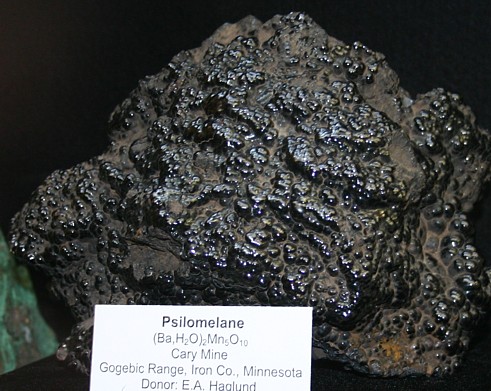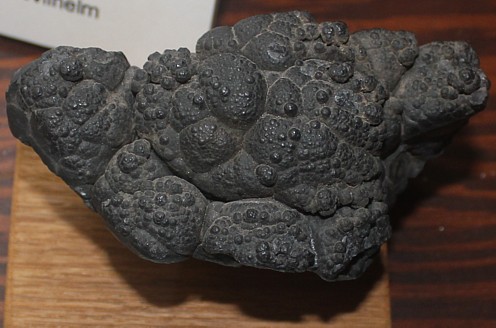|
.
Psilomelane Mineral Facts:
Chemical Formula:
(Ba,H2O)2Mn5O10
Psilomelane is probably a mixture of colloidal oxides and hydroxides
of manganese in various proportions. In most specimens there is a
notable percentage of Barium or potassium oxides present, and in others small quantities
of lithium and thallium can be found.
Colors:
Black.
Its streak is
Brownish black.
Hardness:
5.5 to 6
Density: 4.2
Cleavage:
None.
Crystallography: Monoclinic
The mineral occurs in globular, botryoidal, stalactitic, and massive
forms exhibiting, in many instances, an obscure fibrous structure.
Luster:.
Dull and
earthy to
submetallic. It is opaque.
|

Psilomelane |
|
Composition,
Structure and Associated Minerals:
Psilomelane occurs in veins associated with
pyrolusite
and other manganese compounds, as nodules in clay beds, and as coatings
on many manganiferous minerals. In all essentially cases it is probably a product
of weathering of other manganese bearing minerals. The name is from the
Greek,
meaning smooth
black, ie., psilos, smooth, and melas, black.
Identification
and Diagnostics
Psilomelane is infusible before the blowpipe, in some cases coloring
the flame green (because of the Barium present) and in others violet (for
potassium). With fluxes it reacts for
manganese.
A small amount of mineral fused in an oxidizing flame with sodium carbonate
gives an opaque bluish green bead.
Borax bead test
gives the same results as with pyrolusite.
In the closed tube it yields much water. It is soluble in HC1with evolution of chlorine
gas.
It is distinguished from most other manganese oxides and hydroxides
by its greater hardness.
|

Botryoidal Psilomelane Aggregate |
|
|
Occurrence,
Localities and Origins:
Psilomelane is of an uncertain composition, chiefly manganese oxides, MnO2 with
MnO and H2O, also small amounts of barium oxide, cobalt oxide, potassium
oxide,
etc. The barium and potassium components are
thought to have been absorbed from the secondary solutions with formed the
mineral. It is basically
amorphous or
non-crystalline, forming massive, botryoidal, or stalactitic deposits.
It is an important manganese ore, occurring usually with othyer manganese
minerals, especially
with pyrolusite.
Psilomelane localities: It is found in large quantity at Elgersburg in Thyringia;
at Ilfeld, Harz; and at various places in Saxony. In the United States
it occurs with pyrolusite and other ores of manganese at Brandon, Vermont;
in the James River Valley, and the Blue Ridge region of Virginia; in
northeastern Tennessee; at Cartersville, Georgia; at Batesville, Arkansas;
and in a stretch of country about forty miles southeast of San
Francisco, California. At many of these points it has been mined as an
ore of manganese.
Wad is a soft, earthy, black or dark brown aggregate of manganese compounds closely related to psilomelane.
It also occurs in globular, botryoidal, stalactitic, flaky and porous
masses, which, in some cases, are so light that they float on water. Like
Psilomelane, it
also occurs in fairly compact layers and coats the surfaces of cracks,
often forming branching stains, known as dendrites.
Wad contains more water than psilomelane, of which it appears
often to be a decomposition product. More frequently it results from
the weathering of manganiferous iron carbonate. It is particularly
abundant in the oxidized portions of veins containing manganese carbonates
and silicates.
Wad is easily distinguished from all other soft black minerals, except
pyrolusite, by the reaction for manganese, and from all other manganese
compounds, except pyrolusite, by its softness. From pyrolusite it is
distinguished by its content of water. It occurs in most of the localities at which other manganese
compounds are found and is mined as an ore of manganese along with the rest
of these minerals.
Return to the
Mineral Collectors Information Page
|


